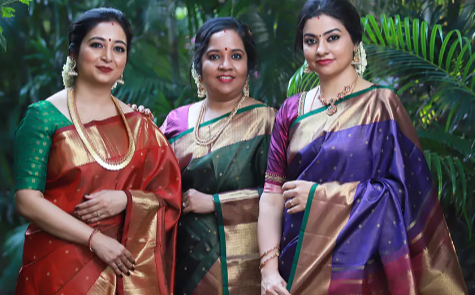Tips for identifying the quality and authenticity of Kanchipuram silk sarees

Identifying the quality and authenticity of Kanchipuram silk sarees requires a discerning eye and knowledge of the intricate craftsmanship that goes into creating these iconic textiles. Kanchipuram sarees, also known as Kanjivaram sarees, originate from the town of Kanchipuram in Tamil Nadu, India. They are renowned for their rich silk texture, vibrant colors, and elaborate zari work. These sarees are cherished not only for their beauty but also for their cultural significance and heritage. Here’s a comprehensive guide to help you distinguish genuine Kanchipuram silk sarees from imitations and appreciate their quality:
1. Understanding Kanchipuram Silk:
Kanchipuram silk sarees are crafted from pure mulberry silk threads, which are known for their durability, natural sheen, and luxurious feel. The silk used in authentic Kanchipuram sarees is sourced from South India, particularly Tamil Nadu and Karnataka, where silk weaving is a traditional art form passed down through generations. The purity of the silk significantly impacts the saree’s quality and how it drapes on the body.
2. Look for Silk Mark Certification:
The Silk Mark certification is a reliable indicator of the saree’s authenticity and quality. Issued by the Silk Mark Organization of India, this certification assures that the silk used in the saree is genuine and meets specified standards. Look for the Silk Mark label or tag attached to the saree, which includes a unique identification number verifying its authenticity.
3. Examining the Silk Quality:
To assess the quality of Kanchipuram silk sarees, start by feeling the fabric. Pure silk has a smooth, soft texture with a natural sheen that catches the light. Run your fingers across the saree to feel its softness and observe how it drapes. Inferior quality silks may feel rough, stiff, or lack the characteristic luster of pure silk.
4. Weight and Density of the Weave:
Authentic Kanchipuram sarees are known for their substantial weight and dense weave. This density is achieved through intricate handloom weaving techniques that use thicker threads for durability and a luxurious feel. Hold the saree up to the light to check for tight weaving and a uniform texture, which indicates skilled craftsmanship.
5. Checking the Zari Work:
Zari refers to the metallic threads, traditionally made of silver or gold, used to embellish Kanchipuram sarees. Genuine zari is made by wrapping silk threads with silver or gold foil, giving it a distinct metallic sheen and durability. Examine the zari motifs and borders of the saree closely. Authentic zari will be fine, tightly woven, and have a rich, shimmering appearance. It should not tarnish or lose its brightness over time.
6. Traditional Weave Patterns and Designs:
Kanchipuram sarees are renowned for their exquisite weave patterns, which are a hallmark of their craftsmanship. Traditional designs include checks, stripes (korvai), temple borders, floral motifs, and geometric patterns inspired by nature and mythology. Each region and community in Kanchipuram has its own weaving techniques and design motifs, reflecting cultural heritage and artisanal skills passed down through generations.
7. Pallu and Border Details:
The pallu, or decorative end piece of the saree, and borders are intricate areas that showcase the skill of the weaver. Traditional Kanchipuram sarees feature broad borders with contrasting colors and elaborate motifs. The pallu often includes complex designs that tell stories or depict religious symbols. Look for precision in weaving, clarity in design, and richness in color combinations, which indicate high-quality craftsmanship.
8. Color Fastness and Dyeing Techniques:
High-quality Kanchipuram silk sarees retain their vibrant colors even after repeated wear and wash. To test color fastness, rub a small portion of the saree with a damp cloth and check if any color transfers. Minimal to no color transfer indicates superior dyeing techniques using natural or eco-friendly dyes that preserve the silk’s integrity and brightness.
9. Price Considerations:
Genuine Kanchipuram silk sarees are handcrafted and labor-intensive, which is reflected in their price. Be cautious of sarees priced significantly lower than the market average, as they may be made from inferior materials or manufactured using shortcuts in weaving and dyeing processes. Quality craftsmanship and pure silk command a higher value due to the artisanal skills and time involved in their creation.
10. Purchase from Reputable Sellers:
When buying Kanchipuram silk sarees, choose reputable sellers, stores, or online platforms known for their commitment to authenticity and quality. Established stores often provide details about the saree’s origin, weaving techniques, and certifications. They may also offer assurances or guarantees regarding the saree’s authenticity and provide after-sales support if needed.
11. Traditional vs. Imitation:
Distinguishing between traditional Kanchipuram silk sarees and imitations requires attention to detail. Authentic sarees are handwoven, which may result in slight irregularities in the weave, adding to their charm and authenticity. Imitations often lack the finesse and durability of genuine Kanchipuram silk and may use synthetic materials or imitation zari that tarnishes quickly.
12. Cultural and Heritage Significance:
Kanchipuram silk sarees hold cultural and heritage significance in Indian tradition. They are worn during weddings, festivals, and special occasions as symbols of grace, elegance, and cultural pride. Understanding the cultural context and significance enhances appreciation for the craftsmanship and artistry behind each saree.
Read more Essential Daily Routines To Keep Your House Clean With Pets
Conclusion:
Identifying the quality and authenticity of Kanchipuram silk sarees involves appreciating the craftsmanship, understanding silk characteristics, and recognizing traditional weaving techniques. By examining the silk quality, checking for Silk Mark certification, evaluating weave patterns and zari work, and purchasing from reputable sellers, you can confidently select sarees that embody the rich heritage and timeless beauty of Kanchipuram silk craftsmanship. Each saree is not just a garment but a testament to centuries-old artisanal skills and cultural legacy, cherished by generations for its elegance and craftsmanship.





